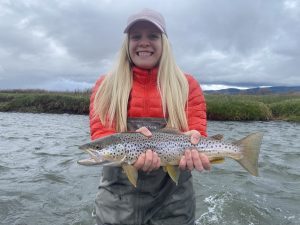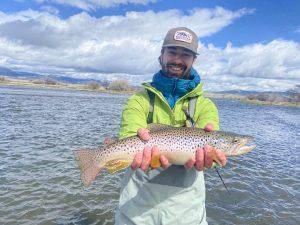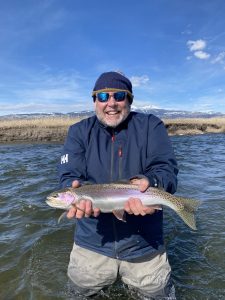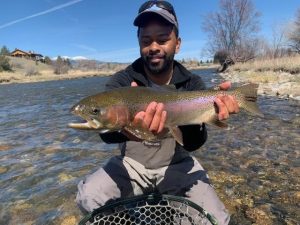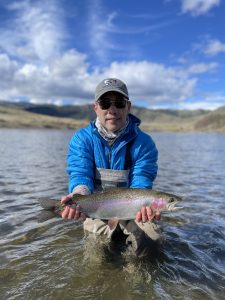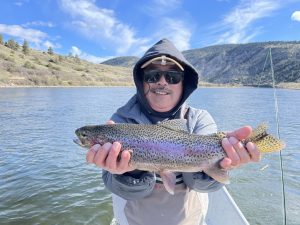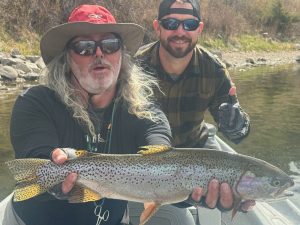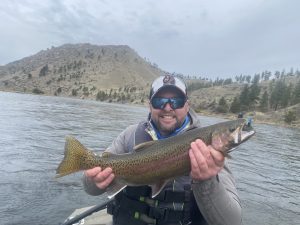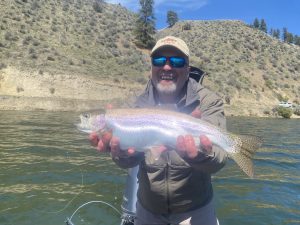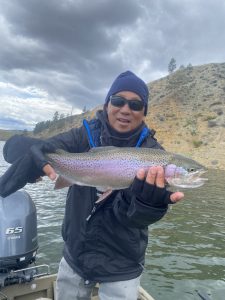In This Newsletter
- New Year-round Regulations for Fishing in Yellowstone National Park
- Yellowstone National Park Opening Day for the 2024 Fishing Season
- How Does Hoot-owl Restrictions Affect You
- Fishing Report
As I write this newsletter, it is currently snowing here in Bozeman. It is much needed, but we prefer it to stay above 7,000 feet and rain in the valleys this time of year. Starting Friday, May 10th, the forecast is supposed to be in the 60s and sunny, with temperatures in the 70s all of next week. This will most likely get our rivers swelling up and turning muddy. Do not worry; sections of the Madison River will be fishable during runoff. The Missouri River in the jet boat and the drift boat sections will also be fishable. All our lakes and spring creeks will be fishable during runoff.
Historically, runoff will peak during the first week in June. After this, rivers will start to come down and clear up, opening up many more opportunities for hungry trout, and eager anglers.
New YNP Fishing Regulations
Beginning Nov. 1, 2024, Yellowstone National Park will expand fishing access by allowing for year-round fishing opportunities at two locations in the park.
- The Madison River from the Wyoming/Montana state line downstream to the park boundary near the West Entrance in West Yellowstone, Montana.
- The Gardner River from Osprey Falls downstream to the confluence with the Yellowstone River near the North Entrance in Gardiner, Montana.
Other fishing areas in the park will continue to be available during the standard fishing season, from the Saturday of Memorial Day weekend through Oct. 31 each year.
The 2024 Yellowstone annual fishing permit will be valid from May 25 through Dec. 31, 2024. Beginning in 2025, the annual fishing permit will be valid for the calendar year, January through December.
Opening Day for Yellowstone National Park
Opening day is the Saturday of Memorial Day weekend, which is May 25th, 2024. Buy your YNP fishing permit HERE.
- Anglers 16 years and older can purchase a three-day ($40), seven-day ($55), or season ($75) permit online HERE. Anglers 15 years of age and younger may fish without a license when supervised by an adult or may obtain a free permit signed by a responsible adult to fish without direct adult supervision. No Montana or Wyoming state fishing license is required in Yellowstone National Park.
- Fishing hours are daily from sunrise to sunset. Fishing with an artificial light is prohibited.
- To reduce the potential for introduction or spread of aquatic invasive species, footgear with absorbent felt or other fibrous material on the soles are prohibited while fishing in Yellowstone.
- Each angler may use only one rod which must be attended at all times and used for angling only—intentional snagging of fish is not allowed.
- Only lead-free artificial lures (e.g. spoon or spinner) or flies may be used. Leaded fishing tackle such as leaded split-shot sinkers, weighted jigs (lead molded to a hook), and soft lead-weighted ribbon for nymph fishing are not allowed.
- Hooks must have points that are barbless, or the barbs must be pinched down by pliers. Lures may have only one hook with a single, double, or treble configuration. A single pointed hook is the best choice for fishing in Yellowstone. Treble hooks (3 points) can severely injure fish and are often constructed with toxic lead solder.
- Each fly may have only one hook. Up to two flies may be used on a single leader (commonly referred to as “dropper,” “dry and dropper,” or “hopper and dropper”).
- Except for feathers and other typical fly-tying materials, the hook must be bare. No organic or inorganic baits are allowed. Organic baits include fish or fish parts, minnows, salmon eggs, worms, insects, or foodstuffs such as bread and corn. Inorganic baits include rubber worms and plastic “twister” tails.
- Scented attractants (liquid and solid baits) are illegal. Putting any substance in the water to attract fish (chumming) is illegal.
Exceptions
- Non-toxic split-shot, sinkers, and jig heads molded with bismuth-tin, molybdenum, or tungsten are allowed. Lead core line and heavy (> 4 lb.) downrigger weights used to fish for deep-dwelling lake trout are permissible because they are too large to be ingested by wildlife.
- Artificial lures are prohibited on the Firehole River, Madison River, and lower Gibbon River below Gibbon Falls. These streams are fly fishing only.
Hoot-Owl Restrictions
Every year, we receive justified concerns from guests who hear about Hoot-Owl restrictions on our local waters and how it will affect their fishing trip. Rest assured, when you hear “the Madison River is closed to fishing”, this does not mean all of the Madison River or all hours of the day. Typically, the lower Madison from Ennis Lake to the headwaters of the Missouri River near Three Forks, Montana, gets put on Hoot-Owl restrictions. This means you cannot fish from 2 pm to midnight.
We also need to understand the origin of this phrase, Hoot-Owl, and the criteria to close our rivers. Provided by Montana FWP.
What is the origin of the phrase “Hoot Owl” restrictions?
The term “Hoot Owl” comes from logging operations in the early 1900s. During the summer months, western forests typically are extremely dry and hot and fire potential is correspondingly also very high. Loggers working in the forests to cut and move trees used a variety of equipment that generated sparks (chain saws, vehicles, metal on metal contact between chains, chokers, and similar). To help prevent fire when conditions were extreme, loggers would stop operations in the afternoon to avoid working in the driest and hottest parts of the day. Morning hours were somewhat safer because of dew and cooler temperatures. Working in these early hours, people would encounter owls that were also active in the morning. Their calls (hooting) lead to reference to the morning work window as the “Hoot Owl.” The term stuck and later came to be associated with human activity conducted only during early hours of the day. At FWP, we use the term “Hoot Owl” to reference drought-related restrictions that allow anglers to fish in the morning (for reasons similar to why loggers would work in the morning incidentally), but not in the afternoon.
12.5.507 ANGLING RESTRICTION AND FISHING CLOSURE CRITERIA
(1) The department shall use the following criteria to determine whether to implement angling restrictions in streams:
(a) angling pressure as determined by the department has the potential to contribute to excessive fish mortality; and
(b) one or more of the following environmental conditions has been determined by the department to exist:
(i) in nonnative salmonid streams designated by the department in the Statewide Fisheries Management Plan, daily maximum water temperatures equal to or exceeding 73 degrees Fahrenheit at any time during the day for three consecutive days;
(ii) in cutthroat trout streams designated by the department in the Statewide Fisheries Management Plan, daily maximum water temperature equal to or exceeding 66 degrees Fahrenheit at any time during the day for three consecutive days;
(iii) in bull trout streams designated by the department in the Statewide Fisheries Management Plan, a daily maximum water temperature equal to or exceeding 60 degrees Fahrenheit at any time during the day for three consecutive days;
(iv) stream flows fall to or below the 5th percentile of daily mean values for this day flow level based upon hydrologic records for that water body; or
(v) water conditions meet the criteria for angling restrictions as stated in a drought management plan; or
(c) other biological or environmental conditions such as, but not limited to, water body pollution, disease, or concentration of angling pressure due to other restrictions or closures that the department determines have the potential to contribute to excessive fish mortality.
(2) A fishing closure may be implemented when:
(a) conditions of (1) develop or degrade;
(b) dissolved oxygen is equal to or less than 4 ppm when measured in the early morning before sunrise; or
(c) water conditions meet the criteria for fishing closures as stated in a drought management plan.
(3) An angling restriction or fishing closure may be delayed or may not be implemented by the department if closure criteria are forecast to be met for a short duration.
When any of the above criteria have been met, fishing closures are typically instated from 2 pm to midnight, when the water temperatures are the warmest.
Anglers must understand the geography of each river, where private lands are, and where most of the irrigation takes place. Fishing above most of the irrigation diversions will provide more and colder water. This is one of many reasons you hire a guide, so you don’t have to worry about where this is.
Historically, from Ennis Lake downstream to Three Forks, Montana, the lower Madison River will be closed to fishing from 2 p.m. to midnight.
Historically, The Gallatin River from Four Corners in Bozeman downstream to Three Forks, Montana, will be closed to fishing from 2 p.m. to midnight.
Historically, the entire Jefferson River is subject to Hoot-Owl restrictions or closures during the warmest parts of the year, July, August, and early September.
Call us at (406)580-7370 for the most up-to-date information you need before you decide to cancel your fishing trip based on what you heard. You can also check the Montana FWP website HERE for the most up-to-date closures.
Fishing Report
The Madison River has been fishing very well and will continue to fish well during runoff. For the most part, we want to stay above the West Fork of the Madison during runoff. This includes one of the wade-only sections from Quake Lake to Lyons Bridge. We will use our boats as taxis to get us from spot to spot. This allows us to access water without trespassing on land and gets us away from the busier public access points like the $3 Dollar Bridge. We can fish from the boat from Lyons Bridge to Palisades FAS; however, we will be confined to the east side and center of the river. The West side will be muddy from the West Fork tributary. We can also fish the lower Madison River from Warmsprings downriver to Greycliff North. However, Cherry Creek will contribute some dirty water on the right side of the river as you are floating downriver.
Cameron Gauging Station on 5/8/24 – 1360 cfs.
Water temperature: 42℉ at noon.
Recommended patterns to have in your box over the next four weeks
Nymphs/Emergers
- Pats Stonefly nymph, black with olive legs – size 8-4
- Pats Stonefly nymph, olive with brown legs – size 12-8
- Lightning Bug, purple and pearl – size 18-14
- Perdigon – Purdee John Brown– size 16-14
- Spanker, pheasant tail, purple– size 16-14
- Green Machine, pt or chartreuse – size 18-14
- CDC Prince – size 16-10
- CDC Baetis Emerger, green & purple – size 16-14
- San Juan Worms, red & orange – size 6-2
- Egg patterns, orange, yellow, or pink – size 16
Dries
- Adams & Parachute Adams – size 18-14
- Purple Haze -size 16-14
- Flushfloater Stone Skwala – size 10
- American March Brown – size 14
- Griffith Gnat – size 22–18
Streamers
- Barely Legal, olive/white – size 6
- Peanut Envy, olive – size 2
- Mike’s Pec’s, olive – size 6
The Missouri River is fishing very well and will continue to fish well through runoff in the jet boat section below Hauser Dam and the drift boat sections below Holter Dam. Because it is dam-controlled, the water released from the reservoirs is clean and clear. We have one major tributary below Holter Dam in the drift boat section, The Dearborn River, which will dump muddy water into the Missouri River. This is approximately 13 miles downriver from the dam. The nymph game will be most productive with eggs, worms, scuds, sowbugs, and beatis patterns. Dry fly fishing has been best in the afternoons, starting around 3 pm, but best in the last couple of hours of light. Streamer anglers are picking up their fair share of trout with small, shiny streamers like the Kreelex.
Holter Dam Gauging Station on 5/8/24 – 4500 cfs.
Water temperature: 44℉ at noon.
Recommended Patterns
Nymphs/Emergers
- Soft Hackle Sow Bug, pink and tan – size 16-12
- Lighting Bug, pink & purple – size 16-14
- Firebead Ray Charles, grey, pink & tan – size 16-14
- Pill Popper – size 16-14
- Perdigon – Purdee John Brown– size 16-14
- Tailwater Sow Bug – size 16-14
- Green Machine – size 16-14
- CDC Baetis Emerger, green & purple – size 16-14
- San Juan Worms, red & orange – size 6-2
- Egg patterns, orange, yellow, or pink – size 16
Dries
- Adams – size 18-16
- Parachute Adams – size 18-16
- Purple Haze – size 18-16
- Griffith Gnat – size 22—18
- Biot Midge, black – size 20-18
- Antonio’s Quill Midge – size 20-18
- Morgans Midge – size 20-18
Streamers
- Kreelex, gold/silver – size 4
- BH (bead head) Wooly Bugger, black – size 8-4
- Sparkle Minnow, olive – size 4
- Zirdle Bug, olive – size 8 (dead drift as a crawfish pattern)
- Balance Leech, Black – size 8
Thank you for staying connected with us on current conditions, reports, and news!
